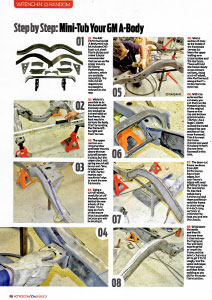
Want a little more tire under your Chevelle (or fill in the name of your favorite GM A-Body)? Whether you’re building a corner-carver, drag race car, daily driver or a cross-county cruiser, or a car that does all of this, having a couple more inches of rear tire width can make a huge improvement in traction. It also makes a huge visual statement. We’re going to walk you through what’s involved in mini tubbing a ’64-’72 GM A-Body using a kit from ABC Performance.
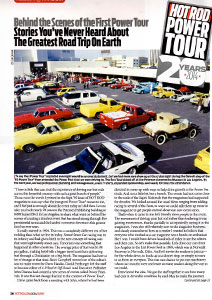
“There is little that can rival the experience of driving our hot rod across this beautiful country with such a great bunch of people.” Those were the words I printed in the September 1995 issue of HOT ROD magazine to sum up what the inaugural Power Tour meant to me, and I feel just as strongly about the event today as I did then. Let me take you back nearly 20 years ago to the Petersen Publishing building at 8490 Sunset Blvd in Los Angeles to share what went on behind the scenes of creating this timeless event that has stood strong through five presidential terms and the hardest economic downturn this generation has ever seen.
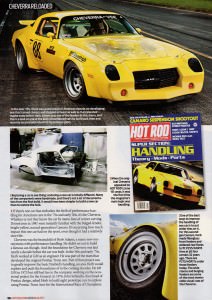
If there’s one car that embodied the birth of performance handling for American cars in the ‘70s and early ‘80s, it was Cheverra. Whether people know the car by name or not, any fans of Detroit iron that could turn corners during this era was familiar with the bulged-fender, bright yellow second-generation Camaro. What’s surprising is the impact that this one car had on the sport even though it had a relatively short life.
Cheverra was the brain child of Herb Adams – a name that is now synonymous with performance handling. He didn’t set out to build a famous car, though. And the foundation for Chevrra was laid nearly a decade before the car was built.
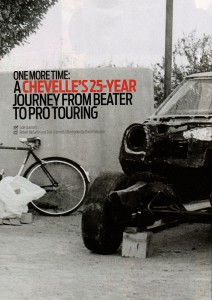
I’m writing this from the driver’s seat of the 1966 Chevelle you see in these pages. Both literally and figuratively. There’s no better place to share this story from. I’ve spent the last 25 years driving this car to school and work, racing it regularly and making change after change to it. This car has been with me through some of my best points in life, and some of my worst. This story really begins in 1986 in Las Cruces, New Mexico. Mike Lane owned this Chevelle, and was trying to build a decent driver out of it.
He had rescued the car from a previous owner who threatened to turn the car into a circle-track racer for the local dirt track if Mike didn’t buy it. Mike and I met through street racing and mutual friends, and I started helping him work on the car when I
Read More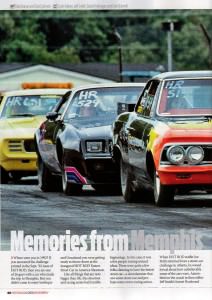
Where were you in 1992? If you answered the challenge printed in the September 1992 issue of HOT ROD magazine to see who was the fastest street car in America, then you are one of 26 guys with a car that made the trip to Memphis. But you didn’t come to enjoy BBQ and drop by Graceland; you were getting ready to throw it down at what would become the inaugural HOT ROD magazine Fastest Street Car in America Shootout.
Like all things that are now bigger than life, this shootout and racing series had some humble beginnings. In this case, it was a few people tossing around ideas. There were quite a few folks who were claiming to have the fastest street car – a doorslammer that saw some street use and perhaps some street racingaction.
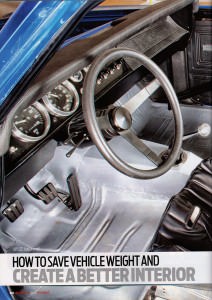
This story is all about form following function. When you build something to perform, it’s hard to avoid making a style faux pas. There are no apologies and no explanation needed. That’s one of the things that make rat rods so cool – they aren’t trying to pretend to be something they’re not. So we wondered what would happen if we styled a muscle car interior after a late ‘60s SCCA Trans Am race car. The racing versions of the cars still retained the classic lines of the production vehicles during this era, and the interiors were stripped and simplified version of the original. They were functional, lightweight and had most of the features that we need in a modern pro touring car with a bent toward performance rather than A/C and other creature comforts.
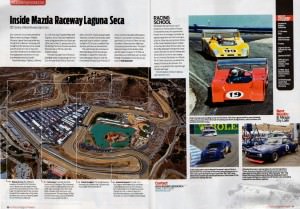
Say “corkscrew” to a car nut and they’re likely to dream up images for Mazda Raceway Laguna Seca long before any thoughts of a cabernet. And along with thoughts of the racetrack comes mental pictures of Can-Am cars or Trans Am racers like Parnelli Jones and Mark Donohue ripping down the famous 10 story drop between turn 8 and 9.
If that’s you, you’re going to dig this new series in Roddin’ at Random. We’ll take a look at some of the most popular racetracks in the U.S., and provide the facts and stories that make them famous. We’ve been lucky enough to visit and even drive on most of these racetracks.In fact, former editor, Rob Kinnan, even has a corner named after him on one of them for his demonstration of an alternate driving line.
Mazda Raceway Lag
Read MoreAs your project progresses from sheet metal repair to body work, one of the things that you’ll want to do is mock up the complete front end.All of that beautiful trim that adorns the front of most muscle cars needs to be carefully fitted at this stage so that you know that everything will fit together after the car is painted. This is especially true if you are changing any of the frontend sheetmetal or trim.
Most of the frontend on this car was replaced with reproduction pieces from National Parts Depot. The front fenders, inner fender wells, bumper, grille, headlight trim, fender eyebrow trim and hood trim are all new. That’s a lot of components that needed to get friendly with each other in order to look like one harmonious car when it all comes together.
When you’ve spent decades learning about and building one type of engine, it can be hard to embrace the new stuff. After all, most of us are building older cars that came with these older engines, we have a slew of parts for the old engines and they work just fine. And, let’sface it, change is painful. If It’s not necessary, why do it? Follow along as we point out the nuances that you’ll need to know. It won’t be too painful to learn a few new tricks!
A full-page of event coverage was included in this issue’s collection of random things of interest to Hot Rod magazine readers. The photography is from the Frankenmuth Auto Fest, a car gathering in Frankenmuth, Michigan, that thousands of cars in a picturesque Bavarian farm town.